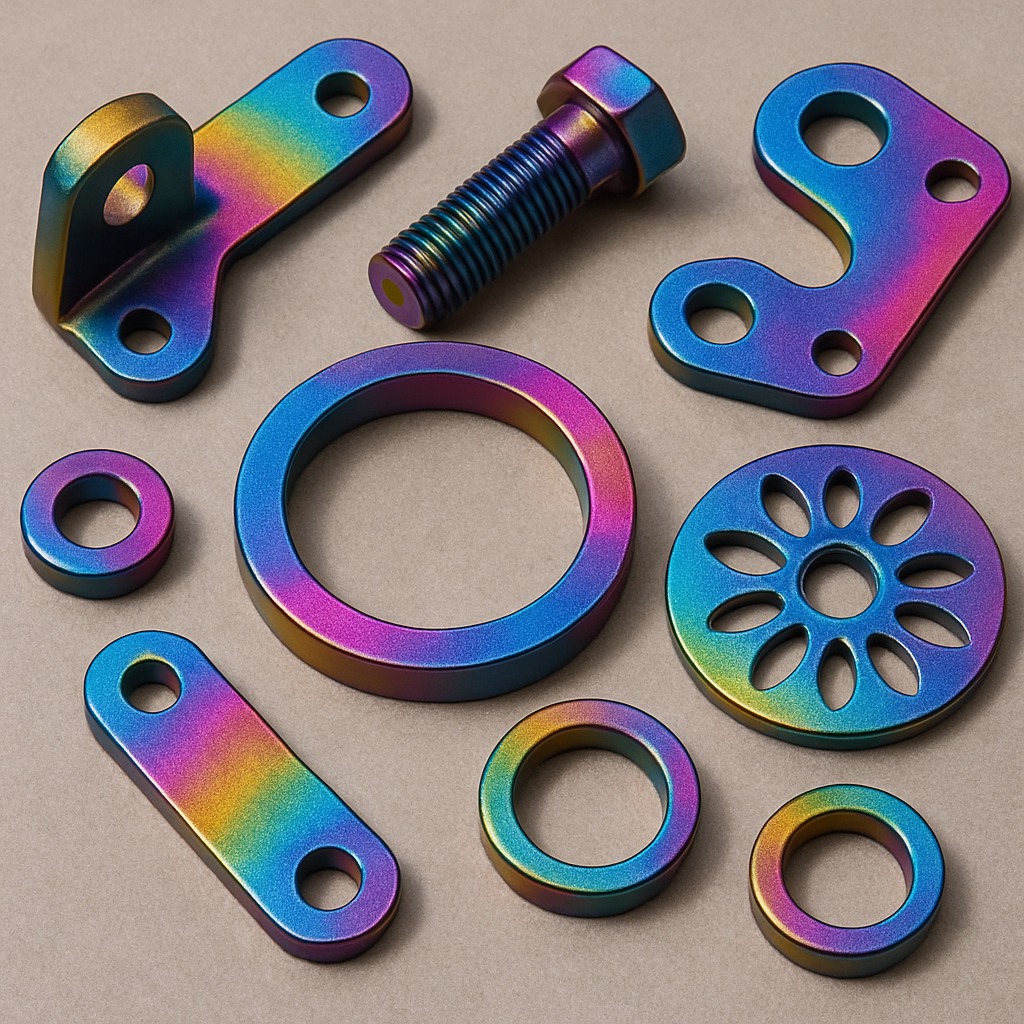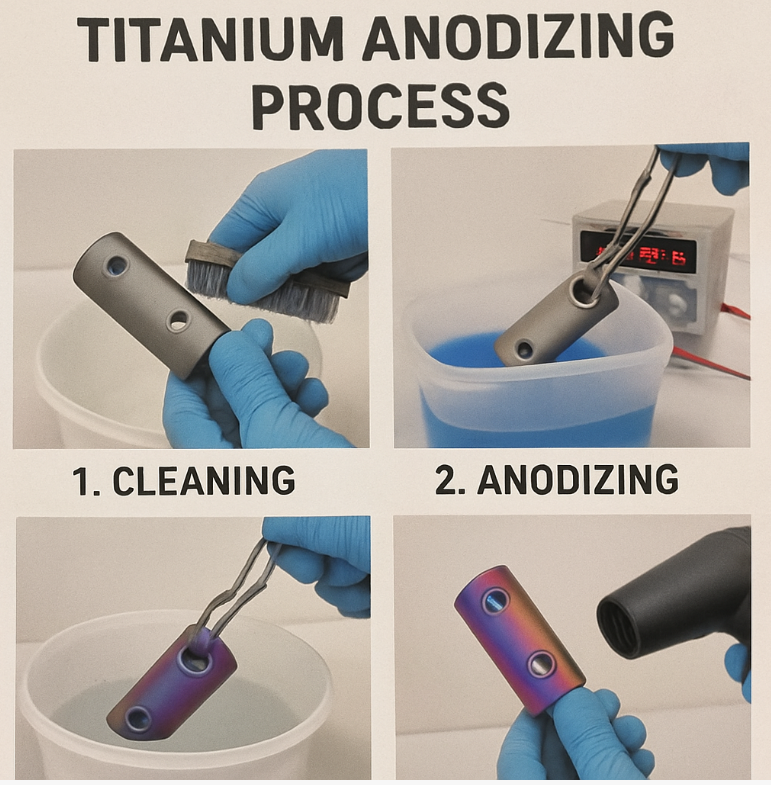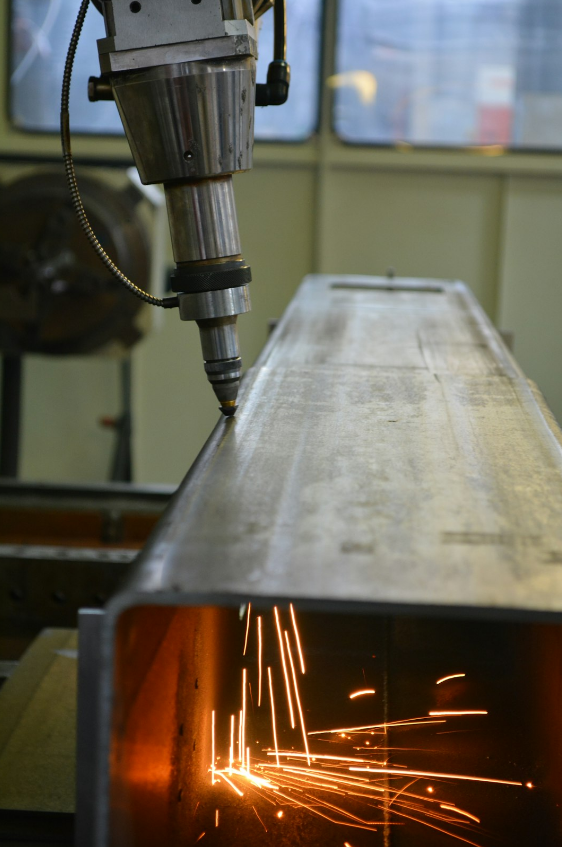Anodizing titanium is an intriguing process that transforms the metal surface into a kaleidoscope of vibrant colors. This technique not only enhances the aesthetic appeal of titanium but also significantly boosts its corrosion resistance, making it a popular choice in various industries. In this comprehensive guide, we will delve into the step-by-step process of anodizing titanium, explore the underlying science, and discuss the numerous benefits it offers.

Anodizing is an electrochemical process that modifies the surface of metals, creating a protective oxide layer. When applied to titanium, anodizing can produce a spectrum of colors without the need for any dyes or pigments. The colors emerge due to the interference of light reflecting off the natural oxide layer that forms on the metal's surface. This natural phenomenon allows titanium to display a range of vibrant hues, including blues, purples, yellows, and more, depending on the thickness of the oxide layer.
The anodizing process is not only about aesthetics; it also enhances the metal's functional properties. By increasing the thickness of the oxide layer, anodizing improves titanium's resistance to wear and corrosion. This makes anodized titanium ideal for applications where durability and longevity are critical, such as in aerospace, medical devices, and consumer electronics. Additionally, the ability to create a variety of colors expands its use in artistic and decorative fields, making anodized titanium a versatile material with both practical and creative applications.
Anodizing titanium offers several compelling benefits:
The anodizing process creates a thicker oxide layer, providing superior protection against environmental factors that can cause corrosion. This makes anodized titanium particularly valuable in harsh environments, such as marine or industrial settings.
The unique ability to produce a wide range of colors makes anodized titanium a popular choice in jewelry, art, and decorative items. Its vibrant colors and metallic sheen can be tailored to specific design preferences, adding a unique visual element to any piece.
The formation of a robust oxide layer not only enhances the metal's aesthetic but also increases its surface hardness. This makes anodized titanium more scratch-resistant and durable, extending the lifespan of products made from it.
By anodizing titanium, manufacturers and artists can achieve a balance of beauty and functionality, making it a sought-after material in various industries. Whether you're creating a statement piece of jewelry or a component for a high-performance application, anodized titanium offers unparalleled versatility.
To understand anodizing, it's essential to grasp how the process alters the metal's surface. Anodizing works by submerging titanium in an electrolyte bath and applying an electrical current. This causes the natural oxide layer on the titanium to thicken, which changes how light interacts with the surface, resulting in different colors. The thickness of the oxide layer determines the color, with thicker layers producing blues and greens and thinner layers resulting in yellows and pinks.
The electrochemical process involves several key reactions that occur at the metal surface. As the electrical current passes through the electrolyte solution, it triggers the oxidation of titanium, forming a thicker oxide layer. This layer is transparent, allowing light to reflect off the metal surface beneath it. The interference of light waves as they pass through the oxide layer and reflect off the metal creates the vibrant colors characteristic of anodized titanium.
Electrolyte Bath: The electrolyte bath is a solution that facilitates the flow of electrical current. It is typically a mixture of water and an acid, such as sulfuric acid or phosphoric acid. The choice of electrolyte can influence the anodizing process and the final color achieved.
Electrical Current: The electrical current applied during anodizing is crucial, as it determines the thickness of the oxide layer and, consequently, the color produced. By adjusting the voltage, you can control the color outcome, allowing for precise customization of the anodized titanium.
Understanding these components and their interactions is vital for successful anodizing. Each factor plays a critical role in determining the final appearance and properties of the anodized titanium, making it essential for practitioners to carefully control the process parameters.

Anodizing titanium is a relatively straightforward process, but it requires careful attention to detail to achieve the desired results. Here's how you can do it:
To begin the anodizing process, you'll need the following materials:
Clean titanium pieces, free of any coatings or contaminants.
An electrolyte bath, which is a mixture of water and an acid, such as sulfuric or phosphoric acid.
A power supply capable of delivering the necessary voltage to achieve the desired oxide layer thickness.
Anodes and cathodes, made of stainless steel or titanium, to complete the electrical circuit.
Safety equipment, including gloves, goggles, and an apron, to protect against acid exposure and electrical hazards.
Having the right materials and safety equipment is crucial for a successful anodizing process. Ensure all components are readily available and in good working condition before you start.
Before anodizing, it's essential to ensure that the titanium pieces are thoroughly cleaned. Any dirt, oil, or fingerprints can affect the final result, leading to uneven coloring or poor adhesion of the oxide layer. Use a degreaser or mild detergent to clean the surface, then rinse thoroughly with distilled water to remove any residues.
Proper cleaning is vital to achieving a uniform and vibrant anodized finish. Take care to handle the cleaned titanium with gloves to avoid reintroducing oils or contaminants from your skin onto the metal surface.
Prepare your electrolyte bath by mixing water with a small amount of acid, following the recommended concentration guidelines. Be sure to follow all safety instructions and wear appropriate protective gear when handling acids, as they can be hazardous.
The composition of the electrolyte bath can influence the anodizing process, affecting both the color and quality of the oxide layer. Pay attention to the acid concentration and ensure the bath is well-mixed before proceeding.
Connect your titanium piece to the positive lead (anode) of your power supply, ensuring a secure connection to avoid electrical issues.
Place a cathode (a piece of stainless steel or titanium) in the electrolyte bath and connect it to the negative lead of the power supply.
Submerge the titanium piece into the electrolyte bath, ensuring it doesn't touch the cathode to prevent short-circuiting and potential damage.
The setup of your anodizing station is crucial for achieving consistent and high-quality results. Double-check all connections and ensure the titanium is fully submerged for even anodization.

The voltage applied will determine the color of the anodized titanium. Lower voltages (around 15-25 volts) produce colors like bronze and purple, while higher voltages (up to 100 volts) can result in blues and greens. Experiment with different voltages to achieve your desired color, keeping in mind that precise control over the voltage is essential for consistent results.
Take note of the voltage settings and corresponding colors achieved to refine your anodizing technique over time. This will help you develop a reliable process for creating specific colors and effects on titanium.
Once the desired color is achieved, carefully remove the titanium from the bath and rinse it with distilled water to remove any residual acid. Allow the piece to dry completely, either by air-drying or using a soft cloth to gently pat the surface.
The rinsing step is crucial to ensure the longevity and appearance of the anodized finish. Residual acid can damage the oxide layer over time, so thorough rinsing is essential to maintaining the quality of the anodized titanium.
Anodizing titanium can sometimes produce unexpected results. Here are some common issues and how to address them:
Uneven Coloring: Ensure the titanium is thoroughly cleaned before anodizing. Uneven cleaning can lead to patchy colors. Re-clean the titanium if necessary and check for any remaining contaminants.
Dull Colors: Check the cleanliness of your electrolyte bath and ensure you're applying the correct voltage. Contaminated baths or incorrect voltage settings can result in less vibrant colors.
No Color Change: Verify that all electrical connections are secure and that the power supply is functioning properly. Double-check the setup and ensure the titanium is fully submerged and making good contact with the anode.
By addressing these common issues, you can improve your anodizing process and achieve more consistent and visually appealing results.
Working with acids and electrical currents requires caution. Always wear safety goggles, gloves, and protective clothing to protect yourself from potential hazards. Ensure your working area is well-ventilated and free from flammable materials to prevent accidents.
Safety should always be a top priority when anodizing titanium. By following proper safety protocols, you can minimize the risk of injury and ensure a safe and successful anodizing experience.Applying voltage to anodize titaniumvolta
Anodizing titanium is a rewarding process that allows you to transform a simple metal into a colorful and durable material. By following this step-by-step guide, you'll be able to anodize titanium pieces to achieve stunning visual effects while enhancing their corrosion resistance. Whether for personal projects or professional applications, anodizing titanium offers endless possibilities for creativity and innovation.
With practice, you'll master the art of titanium anodizing, creating unique and vibrant pieces that stand out with their brilliant colors and enhanced durability. As you gain experience, you'll discover new techniques and color combinations, further expanding your creative potential. Happy anodizing!